Md Abrar Jahin
Reinforcement-Guided Hyper-Heuristic Hyperparameter Optimization for Fair and Explainable Spiking Neural Network-Based Financial Fraud Detection
Aug 23, 2025Abstract:The growing adoption of home banking systems has heightened the risk of cyberfraud, necessitating fraud detection mechanisms that are not only accurate but also fair and explainable. While AI models have shown promise in this domain, they face key limitations, including computational inefficiency, the interpretability challenges of spiking neural networks (SNNs), and the complexity and convergence instability of hyper-heuristic reinforcement learning (RL)-based hyperparameter optimization. To address these issues, we propose a novel framework that integrates a Cortical Spiking Network with Population Coding (CSNPC) and a Reinforcement-Guided Hyper-Heuristic Optimizer for Spiking Systems (RHOSS). The CSNPC, a biologically inspired SNN, employs population coding for robust classification, while RHOSS uses Q-learning to dynamically select low-level heuristics for hyperparameter optimization under fairness and recall constraints. Embedded within the Modular Supervisory Framework for Spiking Network Training and Interpretation (MoSSTI), the system incorporates explainable AI (XAI) techniques, specifically, saliency-based attribution and spike activity profiling, to increase transparency. Evaluated on the Bank Account Fraud (BAF) dataset suite, our model achieves a $90.8\%$ recall at a strict $5\%$ false positive rate (FPR), outperforming state-of-the-art spiking and non-spiking models while maintaining over $98\%$ predictive equality across key demographic attributes. The explainability module further confirms that saliency attributions align with spiking dynamics, validating interpretability. These results demonstrate the potential of combining population-coded SNNs with reinforcement-guided hyper-heuristics for fair, transparent, and high-performance fraud detection in real-world financial applications.
AdeptHEQ-FL: Adaptive Homomorphic Encryption for Federated Learning of Hybrid Classical-Quantum Models with Dynamic Layer Sparing
Jul 09, 2025Abstract:Federated Learning (FL) faces inherent challenges in balancing model performance, privacy preservation, and communication efficiency, especially in non-IID decentralized environments. Recent approaches either sacrifice formal privacy guarantees, incur high overheads, or overlook quantum-enhanced expressivity. We introduce AdeptHEQ-FL, a unified hybrid classical-quantum FL framework that integrates (i) a hybrid CNN-PQC architecture for expressive decentralized learning, (ii) an adaptive accuracy-weighted aggregation scheme leveraging differentially private validation accuracies, (iii) selective homomorphic encryption (HE) for secure aggregation of sensitive model layers, and (iv) dynamic layer-wise adaptive freezing to minimize communication overhead while preserving quantum adaptability. We establish formal privacy guarantees, provide convergence analysis, and conduct extensive experiments on the CIFAR-10, SVHN, and Fashion-MNIST datasets. AdeptHEQ-FL achieves a $\approx 25.43\%$ and $\approx 14.17\%$ accuracy improvement over Standard-FedQNN and FHE-FedQNN, respectively, on the CIFAR-10 dataset. Additionally, it reduces communication overhead by freezing less important layers, demonstrating the efficiency and practicality of our privacy-preserving, resource-aware design for FL.
* Accepted in 1st International Workshop on ICCV'25 BISCUIT (Biomedical Image and Signal Computing for Unbiasedness, Interpretability, and Trustworthiness)
Vision Transformers for End-to-End Quark-Gluon Jet Classification from Calorimeter Images
Jun 17, 2025Abstract:Distinguishing between quark- and gluon-initiated jets is a critical and challenging task in high-energy physics, pivotal for improving new physics searches and precision measurements at the Large Hadron Collider. While deep learning, particularly Convolutional Neural Networks (CNNs), has advanced jet tagging using image-based representations, the potential of Vision Transformer (ViT) architectures, renowned for modeling global contextual information, remains largely underexplored for direct calorimeter image analysis, especially under realistic detector and pileup conditions. This paper presents a systematic evaluation of ViTs and ViT-CNN hybrid models for quark-gluon jet classification using simulated 2012 CMS Open Data. We construct multi-channel jet-view images from detector-level energy deposits (ECAL, HCAL) and reconstructed tracks, enabling an end-to-end learning approach. Our comprehensive benchmarking demonstrates that ViT-based models, notably ViT+MaxViT and ViT+ConvNeXt hybrids, consistently outperform established CNN baselines in F1-score, ROC-AUC, and accuracy, highlighting the advantage of capturing long-range spatial correlations within jet substructure. This work establishes the first systematic framework and robust performance baselines for applying ViT architectures to calorimeter image-based jet classification using public collider data, alongside a structured dataset suitable for further deep learning research in this domain.
Soybean Disease Detection via Interpretable Hybrid CNN-GNN: Integrating MobileNetV2 and GraphSAGE with Cross-Modal Attention
Mar 03, 2025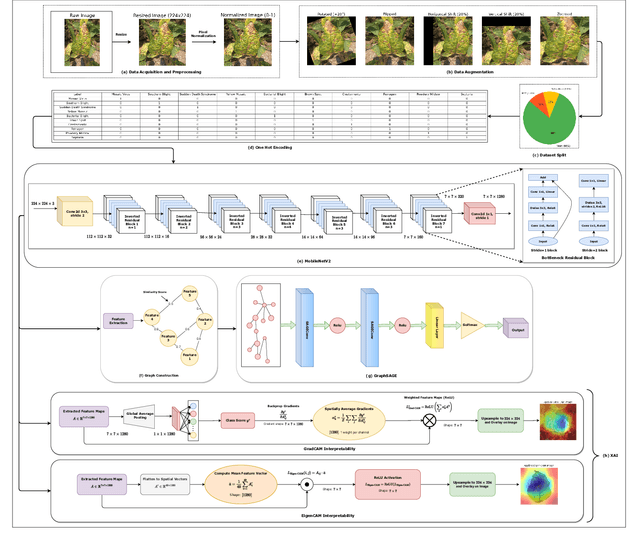
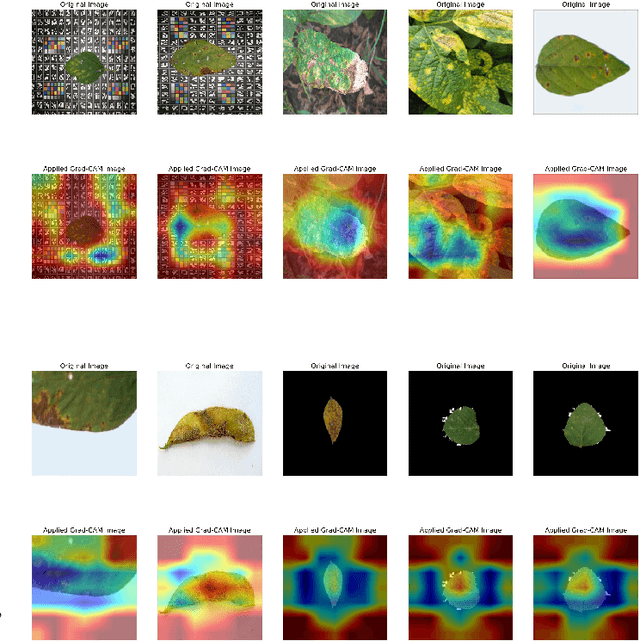
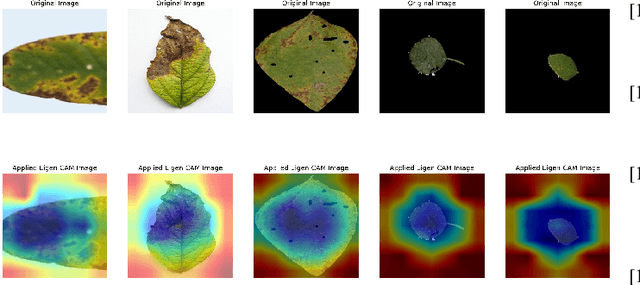
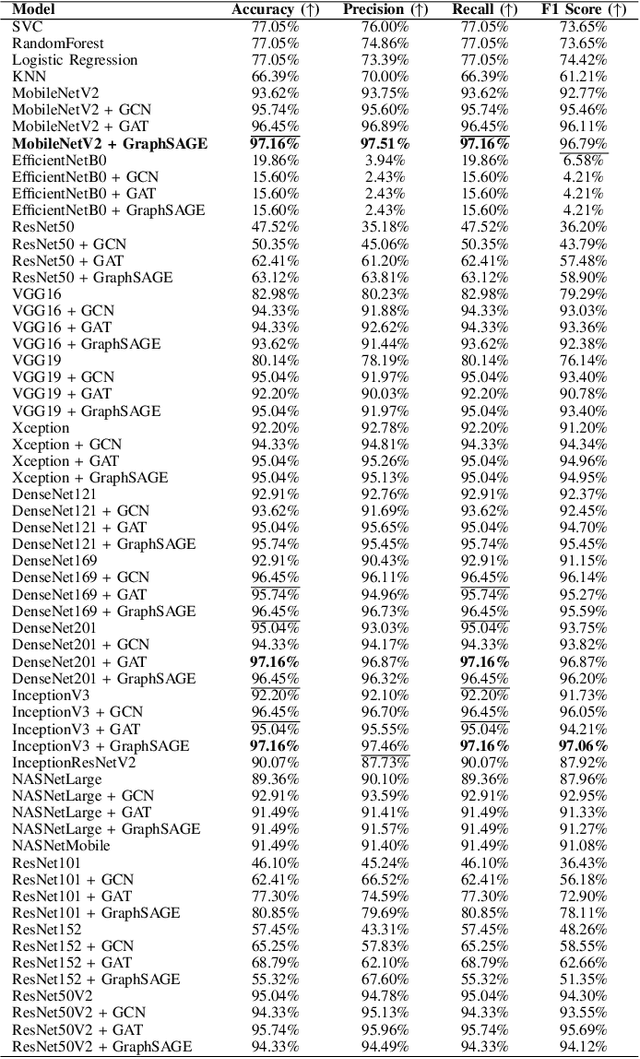
Abstract:Soybean leaf disease detection is critical for agricultural productivity but faces challenges due to visually similar symptoms and limited interpretability in conventional methods. While Convolutional Neural Networks (CNNs) excel in spatial feature extraction, they often neglect inter-image relational dependencies, leading to misclassifications. This paper proposes an interpretable hybrid Sequential CNN-Graph Neural Network (GNN) framework that synergizes MobileNetV2 for localized feature extraction and GraphSAGE for relational modeling. The framework constructs a graph where nodes represent leaf images, with edges defined by cosine similarity-based adjacency matrices and adaptive neighborhood sampling. This design captures fine-grained lesion features and global symptom patterns, addressing inter-class similarity challenges. Cross-modal interpretability is achieved via Grad-CAM and Eigen-CAM visualizations, generating heatmaps to highlight disease-influential regions. Evaluated on a dataset of ten soybean leaf diseases, the model achieves $97.16\%$ accuracy, surpassing standalone CNNs ($\le95.04\%$) and traditional machine learning models ($\le77.05\%$). Ablation studies validate the sequential architecture's superiority over parallel or single-model configurations. With only 2.3 million parameters, the lightweight MobileNetV2-GraphSAGE combination ensures computational efficiency, enabling real-time deployment in resource-constrained environments. The proposed approach bridges the gap between accurate classification and practical applicability, offering a robust, interpretable tool for agricultural diagnostics while advancing CNN-GNN integration in plant pathology research.
CAGN-GAT Fusion: A Hybrid Contrastive Attentive Graph Neural Network for Network Intrusion Detection
Mar 02, 2025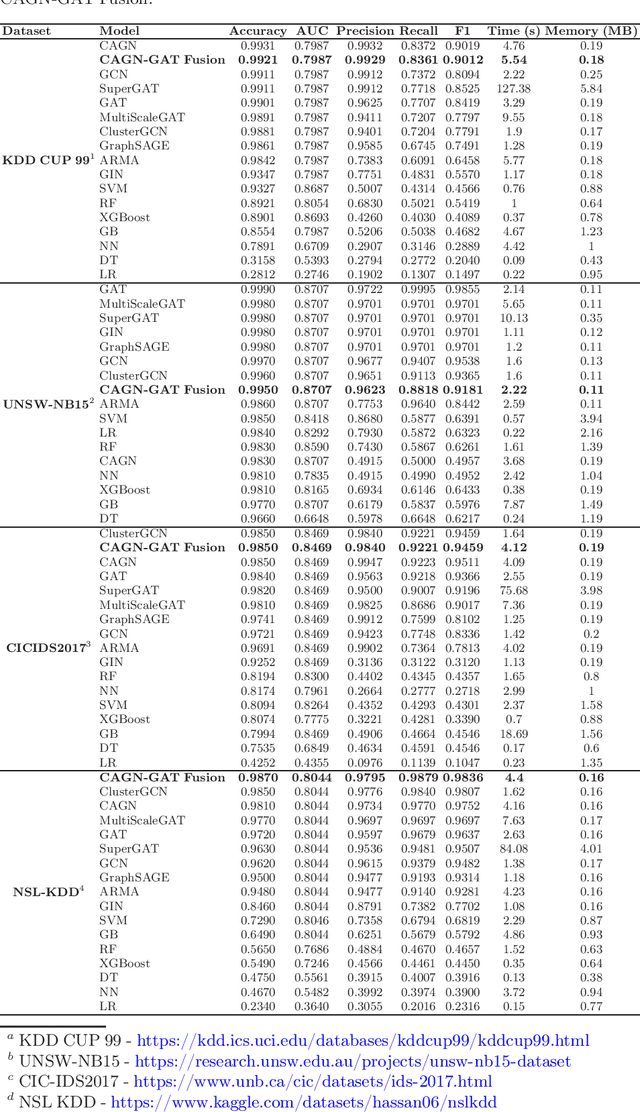
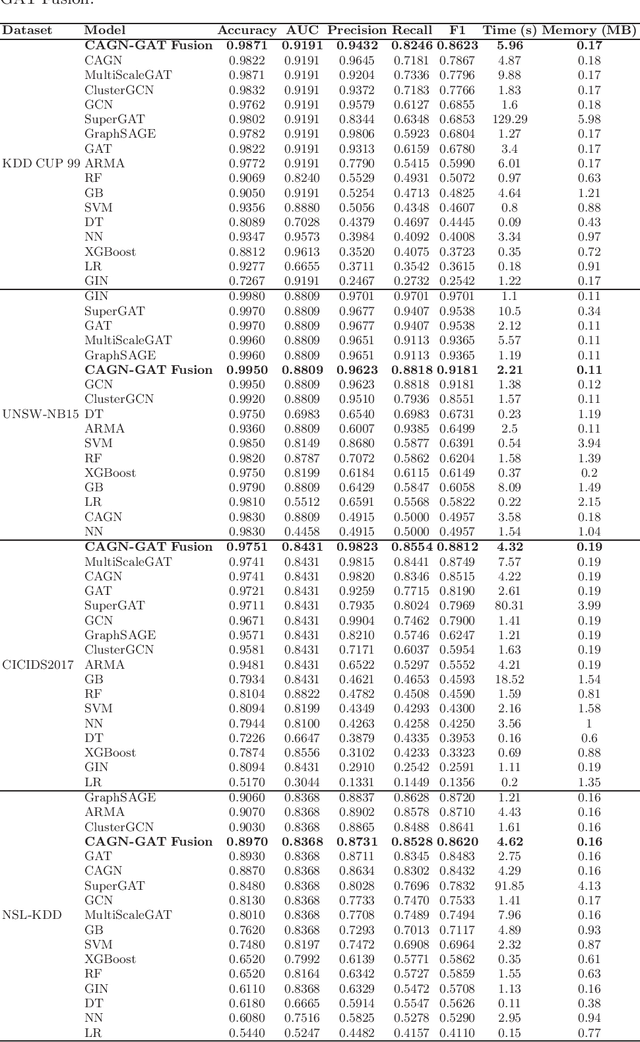
Abstract:Cybersecurity threats are growing, making network intrusion detection essential. Traditional machine learning models remain effective in resource-limited environments due to their efficiency, requiring fewer parameters and less computational time. However, handling short and highly imbalanced datasets remains challenging. In this study, we propose the fusion of a Contrastive Attentive Graph Network and Graph Attention Network (CAGN-GAT Fusion) and benchmark it against 15 other models, including both Graph Neural Networks (GNNs) and traditional ML models. Our evaluation is conducted on four benchmark datasets (KDD-CUP-1999, NSL-KDD, UNSW-NB15, and CICIDS2017) using a short and proportionally imbalanced dataset with a constant size of 5000 samples to ensure fairness in comparison. Results show that CAGN-GAT Fusion demonstrates stable and competitive accuracy, recall, and F1-score, even though it does not achieve the highest performance in every dataset. Our analysis also highlights the impact of adaptive graph construction techniques, including small changes in connections (edge perturbation) and selective hiding of features (feature masking), improving detection performance. The findings confirm that GNNs, particularly CAGN-GAT Fusion, are robust and computationally efficient, making them well-suited for resource-constrained environments. Future work will explore GraphSAGE layers and multiview graph construction techniques to further enhance adaptability and detection accuracy.
DGNN-YOLO: Interpretable Dynamic Graph Neural Networks with YOLO11 for Small Object Detection and Tracking in Traffic Surveillance
Dec 11, 2024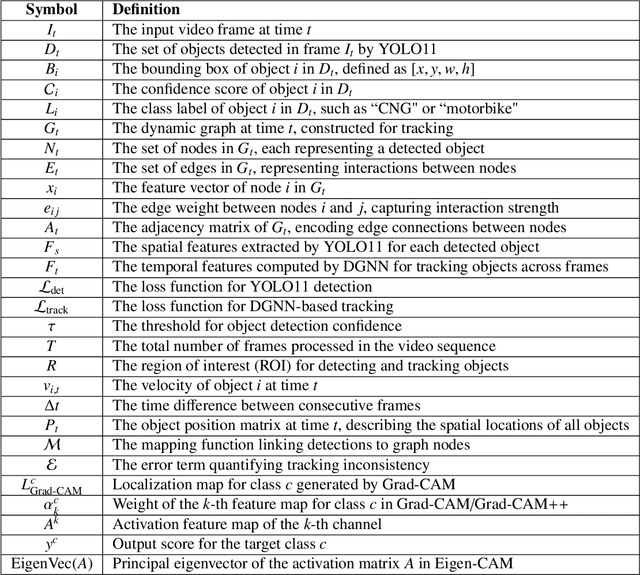
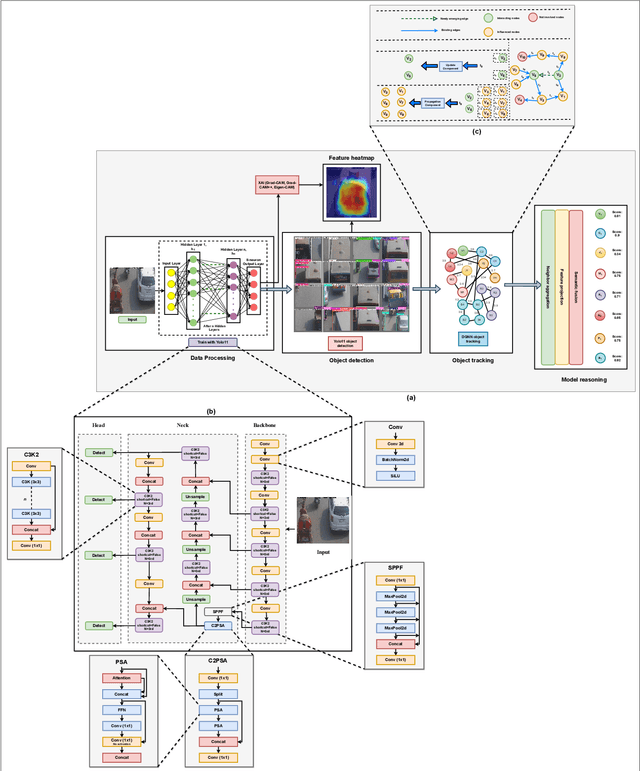
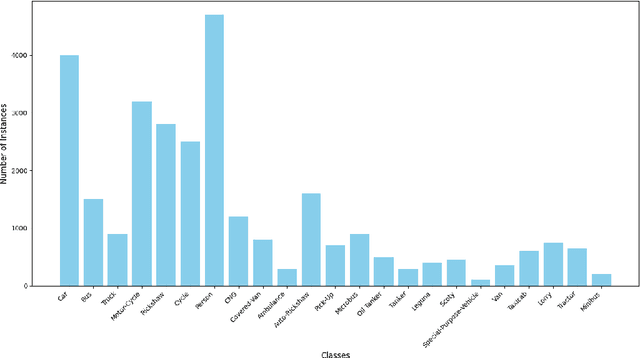

Abstract:Accurate detection and tracking of small objects, such as pedestrians, cyclists, and motorbikes, is critical for traffic surveillance systems, which are crucial for improving road safety and decision-making in intelligent transportation systems. However, traditional methods face challenges such as occlusion, low resolution, and dynamic traffic conditions, necessitating innovative approaches to address these limitations. This paper introduces DGNN-YOLO, a novel framework integrating dynamic graph neural networks (DGNN) with YOLO11 to enhance small-object detection and tracking in traffic surveillance systems. The framework leverages YOLO11's advanced spatial feature extraction capabilities for precise object detection and incorporates a DGNN to model spatial-temporal relationships for robust real-time tracking dynamically. By constructing and updating graph structures, DGNN-YOLO effectively represents objects as nodes and their interactions as edges, thereby ensuring adaptive and accurate tracking in complex and dynamic environments. Additionally, Grad-CAM, Grad-CAM++, and Eigen-CAM visualization techniques were applied to DGNN-YOLO to provide model-agnostic interpretability and deeper insights into the model's decision-making process, enhancing its transparency and trustworthiness. Extensive experiments demonstrated that DGNN-YOLO consistently outperformed state-of-the-art methods in detecting and tracking small objects under diverse traffic conditions, achieving the highest precision (0.8382), recall (0.6875), and mAP@0.5:0.95 (0.6476), showing its robustness and scalability, particularly in challenging scenarios involving small and occluded objects. This study provides a scalable, real-time traffic surveillance and analysis solution, significantly contributing to intelligent transportation systems.
A Unified Framework for Evaluating the Effectiveness and Enhancing the Transparency of Explainable AI Methods in Real-World Applications
Dec 05, 2024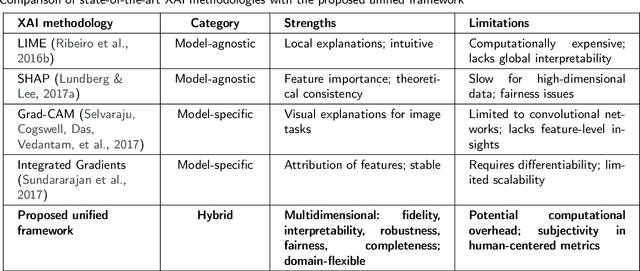
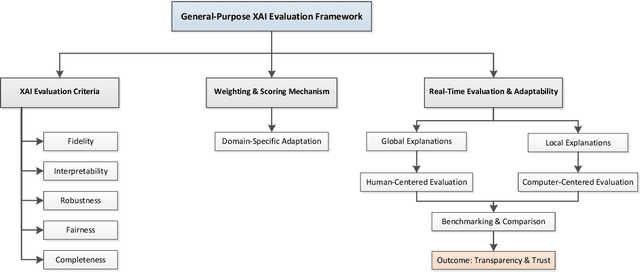
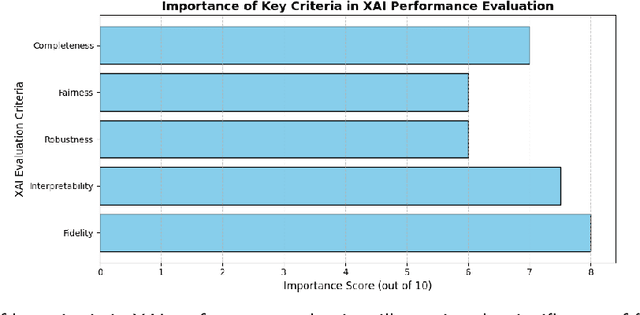
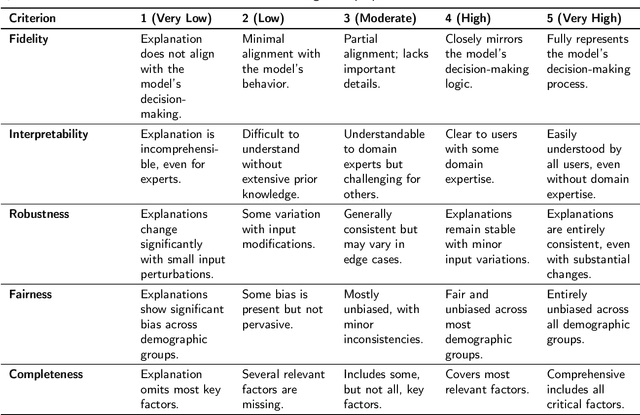
Abstract:The rapid advancement of deep learning has resulted in substantial advancements in AI-driven applications; however, the "black box" characteristic of these models frequently constrains their interpretability, transparency, and reliability. Explainable artificial intelligence (XAI) seeks to elucidate AI decision-making processes, guaranteeing that explanations faithfully represent the model's rationale and correspond with human comprehension. Despite comprehensive research in XAI, a significant gap persists in standardized procedures for assessing the efficacy and transparency of XAI techniques across many real-world applications. This study presents a unified XAI evaluation framework incorporating extensive quantitative and qualitative criteria to systematically evaluate the correctness, interpretability, robustness, fairness, and completeness of explanations generated by AI models. The framework prioritizes user-centric and domain-specific adaptations, hence improving the usability and reliability of AI models in essential domains. To address deficiencies in existing evaluation processes, we suggest defined benchmarks and a systematic evaluation pipeline that includes data loading, explanation development, and thorough method assessment. The suggested framework's relevance and variety are evidenced by case studies in healthcare, finance, agriculture, and autonomous systems. These provide a solid basis for the equitable and dependable assessment of XAI methodologies. This paradigm enhances XAI research by offering a systematic, flexible, and pragmatic method to guarantee transparency and accountability in AI systems across many real-world contexts.
DGNN-YOLO: Dynamic Graph Neural Networks with YOLO11 for Small Object Detection and Tracking in Traffic Surveillance
Nov 26, 2024



Abstract:Accurate detection and tracking of small objects such as pedestrians, cyclists, and motorbikes are critical for traffic surveillance systems, which are crucial in improving road safety and decision-making in intelligent transportation systems. However, traditional methods struggle with challenges such as occlusion, low resolution, and dynamic traffic conditions, necessitating innovative approaches to address these limitations. This paper introduces DGNN-YOLO, a novel framework integrating dynamic graph neural networks (DGNN) with YOLO11 to enhance small object detection and tracking in traffic surveillance systems. The framework leverages YOLO11's advanced spatial feature extraction capabilities for precise object detection and incorporates DGNN to model spatial-temporal relationships for robust real-time tracking dynamically. By constructing and updating graph structures, DGNN-YOLO effectively represents objects as nodes and their interactions as edges, ensuring adaptive and accurate tracking in complex and dynamic environments. Extensive experiments demonstrate that DGNN-YOLO consistently outperforms state-of-the-art methods in detecting and tracking small objects under diverse traffic conditions, achieving the highest precision (0.8382), recall (0.6875), and mAP@0.5:0.95 (0.6476), showcasing its robustness and scalability, particularly in challenging scenarios involving small and occluded objects. This work provides a scalable, real-time traffic surveillance and analysis solution, significantly contributing to intelligent transportation systems.
Designing Cellular Manufacturing System in Presence of Alternative Process Plans
Nov 22, 2024



Abstract:In the design of cellular manufacturing systems (CMS), numerous technological and managerial decisions must be made at both the design and operational stages. The first step in designing a CMS involves grouping parts and machines. In this paper, four integer programming formulations are presented for grouping parts and machines in a CMS at both the design and operational levels for a generalized grouping problem, where each part has more than one process plan, and each operation of a process plan can be performed on more than one machine. The minimization of inter-cell and intra-cell movements is achieved by assigning the maximum possible number of consecutive operations of a part type to the same cell and to the same machine, respectively. The suitability of minimizing inter-cell and intra-cell movements as an objective, compared to other objectives such as minimizing investment costs on machines, operating costs, etc., is discussed. Numerical examples are included to illustrate the workings of the formulations.
Solving Generalized Grouping Problems in Cellular Manufacturing Systems Using a Network Flow Model
Nov 07, 2024
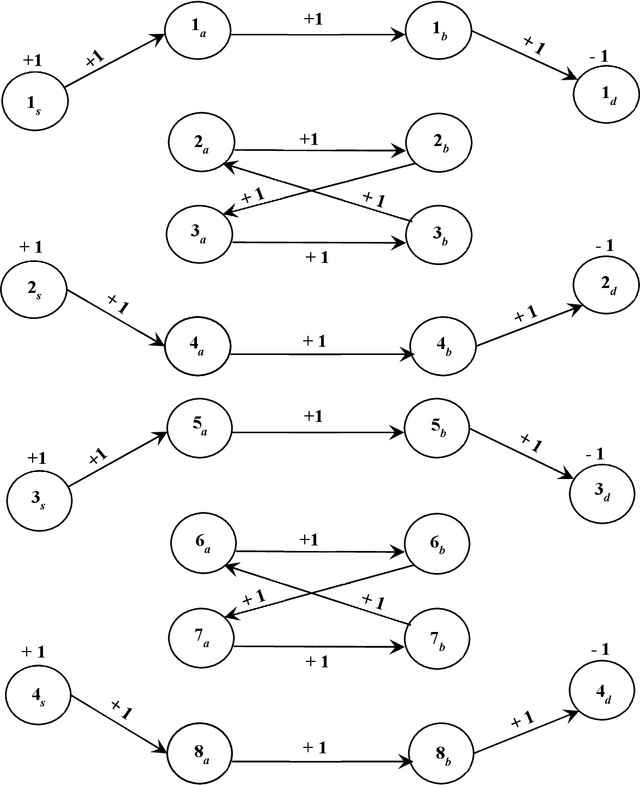


Abstract:This paper focuses on the generalized grouping problem in the context of cellular manufacturing systems (CMS), where parts may have more than one process route. A process route lists the machines corresponding to each part of the operation. Inspired by the extensive and widespread use of network flow algorithms, this research formulates the process route family formation for generalized grouping as a unit capacity minimum cost network flow model. The objective is to minimize dissimilarity (based on the machines required) among the process routes within a family. The proposed model optimally solves the process route family formation problem without pre-specifying the number of part families to be formed. The process route of family formation is the first stage in a hierarchical procedure. For the second stage (machine cell formation), two procedures, a quadratic assignment programming (QAP) formulation and a heuristic procedure, are proposed. The QAP simultaneously assigns process route families and machines to a pre-specified number of cells in such a way that total machine utilization is maximized. The heuristic procedure for machine cell formation is hierarchical in nature. Computational results for some test problems show that the QAP and the heuristic procedure yield the same results.
 Add to Chrome
Add to Chrome Add to Firefox
Add to Firefox Add to Edge
Add to Edge